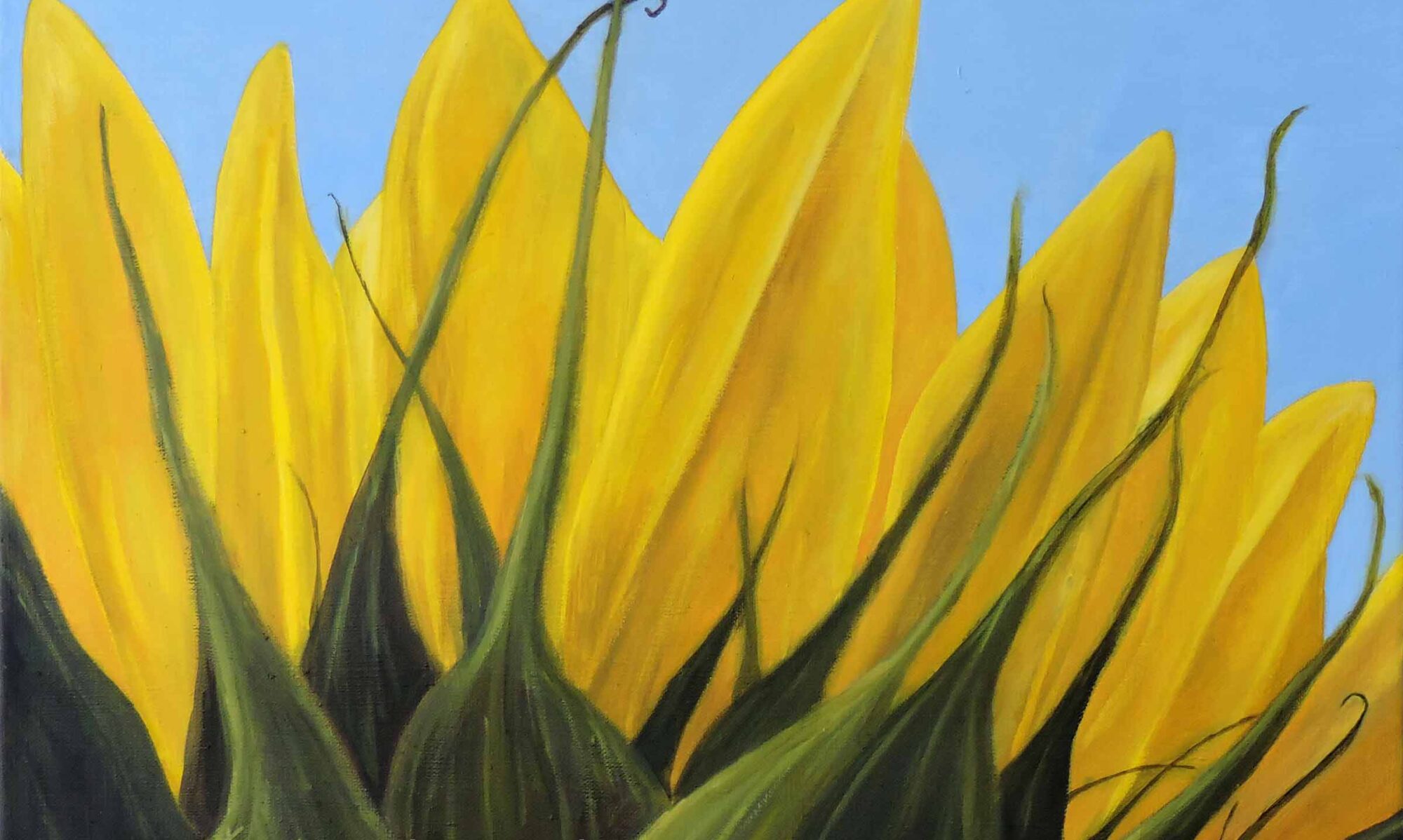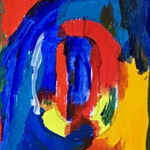
OCCULT BALANCE | OVERSIZED PAINTINGS
Quick links to more art terms and definitions are located at the end of the list.
Occult Balance
Refers to an asymmetrical mode of composition where visual elements are balanced in a way that isn’t immediately obvious. This technique is often used in flower arrangements, Chinese and Japanese painting, and other forms of art to create a sense of harmony and equilibrium without relying on symmetry. In occult balance, elements such as color, shape, and texture are arranged to counterbalance each other, creating a composition that feels stable and aesthetically pleasing despite its asymmetry.
Oeuvre
(Pronounced “OO-vruh.”)
Refers to the complete body of work produced by an artist throughout their career. This term encompasses all the various pieces created by the artist, including paintings, sculptures, drawings, and other forms of artistic expression. An artist’s oeuvre provides insight into their development, thematic interests, and stylistic evolution over time.
Oil Paint
An art medium used by artists since the 1500s. Oil paint is a slow-drying medium made from ground pigment suspended in a natural drying oil, which is usually linseed oil, but can also be walnut or poppyseed oil. It can be applied thick or thin and can be used with glazes. Oil paint’s slow drying makes it easier to blend from dark to light, creating three-dimensional illusions. Its richness and glow make it popular among painters. Clean-up involves using turpentine or mineral spirits.
Oil Painting
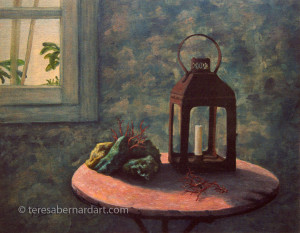
An artistic composition or representation done with oil paints on a canvas surface. Also refers to the art or practice of painting with oil paints. Oil painting artists are often referred to as painters. Some of the most famous oil painters in history include Leonardo da Vinci, Michelangelo Buonarotti, Vincent van Gogh, Johannes Vermeer, and Rembrandt van Rijn.
Oil Pastels
Refers to sticks made by combining finely ground pigment with a non-drying oil and a wax binder. Oil pastels are known for their intense and vibrant hues. They blend beautifully, allowing artists to create smooth transitions between colors. These pastels are a fascinating art medium that combines the best of both crayons and traditional pastels. Unlike traditional pastels, they don’t dry out, which means they remain workable indefinitely. Artists can use them for drawing, painting, and mixed media projects. See also Pastels.
The features of soft pastels are:
-
- Unique Texture: Made with mineral oil and wax, giving them a distinct consistency.
- Never Fully Dry: Unlike oil paints, they won’t fully dry.
- Use: Bold, vibrant colors; suitable for canvas, paper, and board.
- Framing: Frame under glass to preserve them.
Oiling Out
A technique where a thin layer of oil is applied to a dried layer of oil paint to make it more flexible and workable. This process allows improved color blending, smoother transitions, and an even surface. It also serves to equalize the sheen of the painting’s surface, enabling the artist to assess the remaining work needed to complete the artwork. Additionally, it enhances the saturation of the colors in an oil painting, rejuvenating it if it has become dull or faded. Once the oiling out process is complete, the artist can either continue painting or allow it to dry.
Old Master
A term that refers to a prominent and highly skilled European artist from approximately 1300 to 1800, as well as the artwork created by such an esteemed artist. The term gained prominence from the 18th century onward due to European art academies and galleries codifying what was considered ‘good’ historical art. Some of the most renowned Old Masters include:
-
- Leonardo da Vinci, Michelangelo, Raphael, and Titian from the Renaissance period
- Rembrandt van Rijn and Jan van Eyck of the Baroque era
- J.M.W. Turner from the Romantic era
Ombre
A visual effect in which a single color gradually transitions from one shade to another, typically moving from light to dark or vice versa. This technique is widely used in various forms of art, including painting, fashion, and interior design, to create depth and visual interest. The seamless blending of tones gives a smooth gradient effect, enhancing the overall aesthetic of the artwork or design.
On-Chain Art
Refers to a type of digital art called NFTs (non-fungible tokens) that is created using generative algorithms that are coded and completely stored on a blockchain. This enables the development of one-of-a-kind, verifiable digital artworks, as well as a secure and transparent method of verifying the artwork’s authenticity and tracking its ownership history.
One-Point Perspective
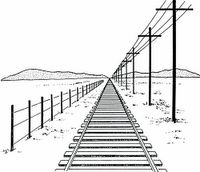
The simplest method of drawing perspective. It uses only a single vanishing point on the horizon line. A vanishing point is where two or more parallel lines converge into each other at “infinity.” A long hallway, railroad track, or road with the viewer positioned face-on and looking down the center is an excellent example of this perspective. As seen in the illustration, the two tracks are parallel to each other, and you know they will remain the same distance apart. However, the further away they get, the closer they appear to be until they eventually disappear at the horizon.
Op Art (Optical Art)
An art movement that originated in the 1960s. It employs optical illusions to engage and mesmerize the viewer. Characterized by its use of bold colors or stark black-and-white contrasts, Op Art features geometric patterns and lines. It often utilizes precise mathematics and abstract shapes to create effects that may give the impression of movement, reveal hidden images, or produce flashing, vibrating patterns, as well as the illusion of swelling or warping. It is distinct from pop art.
Open Composition
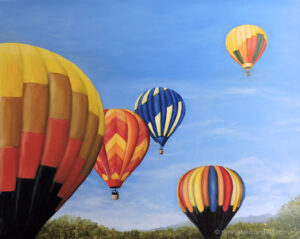
A compositional technique where elements of an image run off the edges and seemingly beyond the boundaries of the canvas, drawing the viewer inside the scene making it easy to imagine what is happening outside of the physical edges of the artwork. Landscapes are prime examples of open compositions.
An open composition is the opposite of “closed composition.”
Optical Mixing
Also known as partitive color, this phenomenon occurs when two or more colors placed near each other create the illusion of new colors. Unlike traditional color mixing, which involves physically mixing pigments to create new colors, partitive color occurs perceptually, between our eyes and our brain. The perceived mixing increases with distance.
Orange

A secondary color that results from the combination of two primary colors, specifically red and yellow. Orange is the complement or opposite of the color blue. The color of carrots, pumpkins, sweet potatoes, oranges, and many other fruits and vegetables.
Organic Form
Refers to shapes and structures in art that are free-flowing, irregular, and often inspired by nature. These forms typically lack the rigid, geometric lines found in mechanical or man-made objects, instead mimicking the curves, undulations, and asymmetry seen in natural elements like plants, rocks, and living organisms. Organic forms can be found in various art movements and styles, including Art Nouveau, where the fluid, natural shapes are prominent, and in the works of modern and contemporary artists who seek to capture the essence of the natural world.
Orientalism
Refers to the representation of the East—particularly regions like the Middle East, North Africa, India, China, and Turkey—by Western writers, designers, and artists. This artistic movement gained prominence during the 19th century and blurred the line between fantasy and reality. Orientalist art encompassed various forms, including impressive oil paintings, works on paper, and decorative arts. Artists depicted scenes, landscapes, people, architecture, and cultural objects drawn from Eastern countries.
Origami
The Japanese art of folding paper into shapes that look like birds, animals, etc. The object is to transform a flat square sheet of paper into a finished sculpture through folding and sculpting techniques.
Original (work of art)
This refers to an artwork that is the first of its kind, created by the artist’s own hand. It is not a copy, reproduction, or imitation, but a unique piece that showcases the artist’s individual creativity and techniques.
Original Oil Paintings
Unique artworks created using oil-based paints, typically applied to canvas or other suitable surfaces. These paintings are characterized by their individuality, with each piece being a one-of-a-kind creation by the artist. Original oil paintings are valued for their rich colors, textures, and the depth that can be achieved through layering and blending techniques. They differ from reproductions or prints, as each original painting is a distinct expression of the artist’s vision and skill. See blog article “The Timeless Allure of Original Oil Paintings.”
Key Characteristics:
-
- Unique Creation: Each painting is a one-of-a-kind piece crafted by the artist.
- Artist’s Hand: The work is made by the artist themselves, not through mass-production or mechanical reproduction.
- Traditional Materials: Typically made with oil paints and applied on surfaces like canvas, wood, or linen.
- Authenticity: Often accompanied by signatures, documentation, or provenance that verify its originality and the artist’s identity.
- Artistic Value: Original oil paintings are valued for their creativity, originality, and the skill of the artist.
Orthogonal Lines
Diagonal lines that radiate from or converge to the vanishing point(s). These imaginary lines help artists maintain perspective in their drawings and paintings, ensuring a realistic view of the object. Orthogonal lines can represent the edges of objects, and some can have multiple sets. An example is a box or cube, which can have one, two, or three sets of convergence lines. See also, “Linear Perspective.”
Outline (in art)
Refers to the lines that define the outer edge or contour of an object or figure, separating it from the background and emphasizing its shape and structure. They can be simple, bold, or subtle, providing a clear separation or gradually blending into the surrounding areas. Outlines guide the viewer’s eye, highlighting important elements and conveying the artist’s message. They are particularly prevalent in drawing, illustration, and certain painting styles like comic art and graphic design.
Outsider Art
Refers to artwork by those outside of mainstream society. Outsider art broadly includes folk art, ethnic art, and art by prisoners, the mentally ill, and others neither trained in art nor making their works to sell them.
Overlap Effect
A technique used by artists to create a sense of depth and space within the compositions of their drawings or paintings. This is done by deliberately positioning objects so that some parts are hidden behind others. When an object partially conceals another, it creates a sense of depth and spatial relationships. Essentially, overlapping helps artists convey which objects are in front and which are farther back, contributing to the overall composition and realism of a piece.
Overpainting
Refers to the final layer of paint that is applied over the underpainting (or underlayer) after it has dried. The idea behind layers of painting is that the underpainting serves to define the main outlines and design of the piece, allowing the overpainting to fill in the details.
Oversized Paintings
Large-scale artworks that extend beyond traditional dimensions, often exceeding standard sizes for framed or unframed paintings. These expansive pieces are designed to make a bold visual impact, filling substantial wall space and drawing the viewer’s attention. Oversized paintings are frequently used in galleries, public spaces, and interior design to create dramatic focal points. They may require special considerations for transportation, display, and framing due to their substantial size and weight. See blog article “Oversized Paintings — Unveiling Hidden Treasures.”
You May Also Like
This art definitions sourcebook is provided as a valuable resource for art enthusiasts. If you like the information here and find it helpful, please consider purchasing a painting. Your support helps to cover the cost of keeping this art words and descriptions lexicon online. Simply click or tap the thumbnail link of any Teresa Bernard oil painting to view additional details.
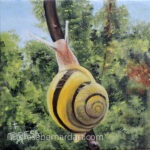
6″ w x 6″ h
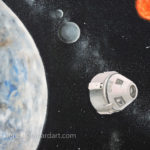
24″ w x 18″ h
Art Glossary Quick Links
Contributing to The Art Dictionary
The sourcebook of art definitions is a work in progress. New terms and definitions are added on a regular basis. If you know of an art term and definition that isn’t already listed in it but you believe it should be, send it to us and we’ll consider adding it. We’ll let you know if we do. Thanks!
Thanks for reading this!
